MANSON EP-925 MODIFICATIONS
Also Conrad, Daiwa, ITG, Palstar, Stabo, Velleman, Voltcraft power supply.
![]() 14-jul-2021
14-jul-2021
|
|
|
EP-925 and PALSTAR PS-30M
On the Internet circulates an unclear copy of this supply's diagram and one is regularly asked for a better drawing. As owner of this device I also wanted a good readable diagram. So I draw a compact one using the Internet's example but it turned out the example had a lot of errors. Therefore it was again drawn according to a MANSON ENGINE RING INDUSTRIAL LTD's Jun 99 redrawn schematic (tnx PAØKV).
Click on Manson for more types of Single Output DC regulated power supply.

The Palstar below is almost similar except two red coloured components.
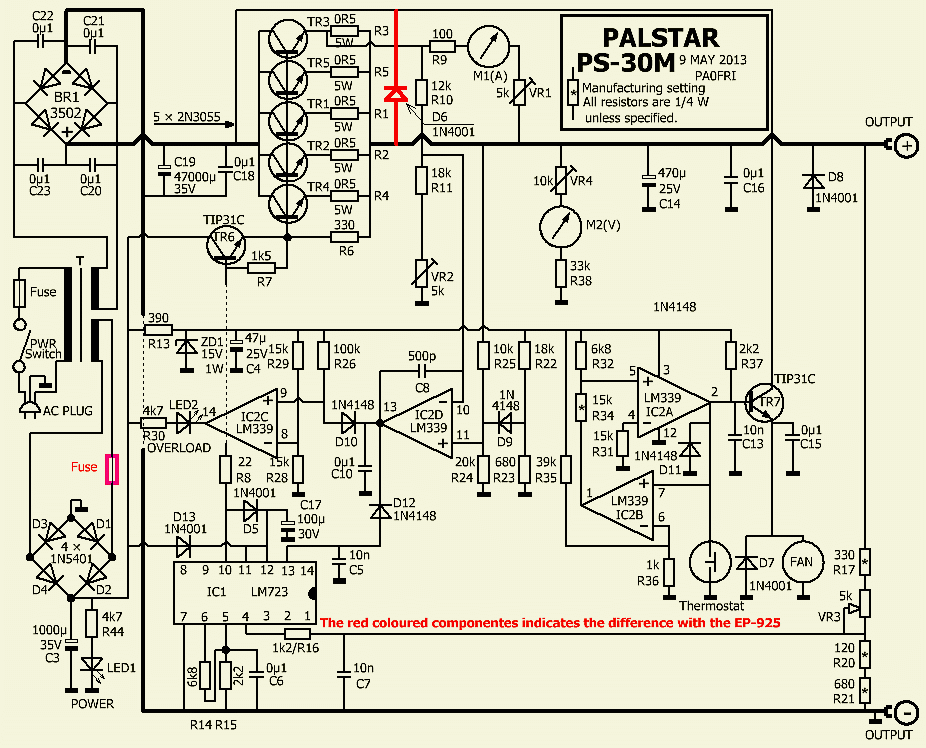
SHORTCOMINGS
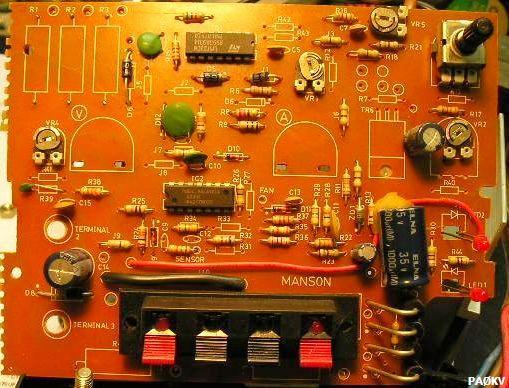
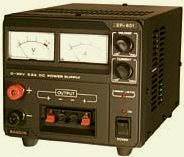
This power supply («fig) is also for sale as EP-925 by Conrad, Daiwa, ITM, Manson, Palstar (PS-30M), Stabo, Velleman, Voltcraft, Dick Smith and others. The unit is used in many shacks but it has some shortcomings, which have resulted in failures. Fortunately the device can be improved by some modifications.
OVERVOLTAGE
Remember that a surge protector is not present. If one transistors (TR1-TR5) blows, the entire unregulated voltage (~ 24V) is connected to your set and it will usually not survive. Such protection is still not in my EP-925 installed. You know the routine, the plan exists but it need not be directly because I have other power supplies available. When use the EP-95 with a transceiver I always connect a small battery in parallel.

At right (fig.1») is the principle of a (15 V) overvoltage protection system. It is almost a standard "brute force" circuit with a Zener diode driving a thyristor, which short-circuit the overvoltage, a fuse blew and the set is no longer energised. Details of such security can be found on the Internet.
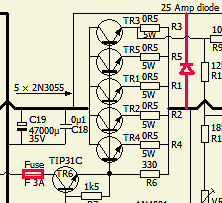 A less crude system (fig.2) is very similar. After turning the main switch and press the start/reset button, the relay connects and the power supply is on. If the voltage at the terminals is too high, the thyristor is conducting and the voltage is reduced to a safe value by the large current through the 0.3 Ohm resistor. Simultaneously, the voltage across the relay is almost zero and disconnects the load. This is not a brute force system and the thyristor is less affected.
A less crude system (fig.2) is very similar. After turning the main switch and press the start/reset button, the relay connects and the power supply is on. If the voltage at the terminals is too high, the thyristor is conducting and the voltage is reduced to a safe value by the large current through the 0.3 Ohm resistor. Simultaneously, the voltage across the relay is almost zero and disconnects the load. This is not a brute force system and the thyristor is less affected.
G3MWO wrote me: "With the crowbar applied, then there is a path from the auxillary smaller power supply up through the TIP31C (TR6) and back through the combined path through the base/collector junctions of all the 2N3055 transistors in parallel" (or via the extra diode #PAØFRI)
In order to protect TR6 install a 3 Amp fast fuse in series with TR6's collector.
OTHER VALUE RESISTORS
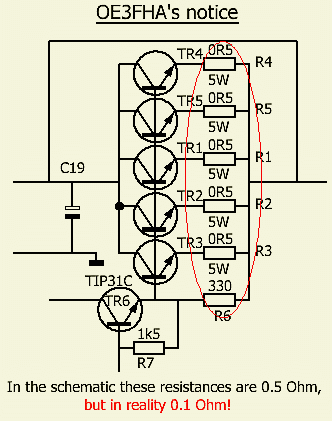
OE3FHA has discovered that unfortunately, a serious error in the "terrible" original circuit is not mentioned. The emitter resistors are indicated with 0.5 Ohm, as one can see in the images of this article and also in the original power supply, they are installed with 0.1 Ohm. These resistors are intended to limit the current and at the same time to compensate for the manufacturing tolerances of the 2N3055. They would be much too large with 0.5 Ohm.
BRIDGE RECTIFIER
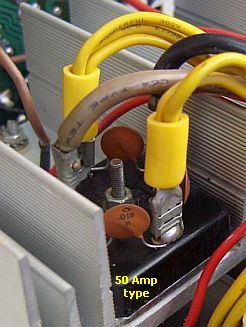
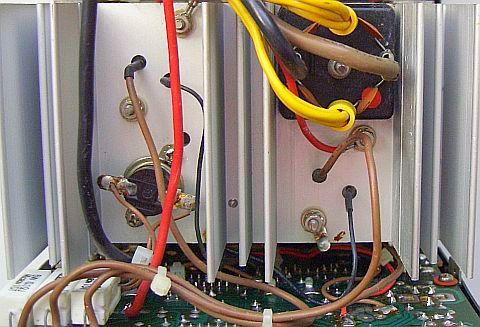
In my EP-925 only a 20 amperes bridge rectifier (DR1) was mounted, but the factory fitted also a 25 Amp type.
Both rectifiers are only suitable for continuous use with about 12 A or 15 A and not to the specifications of a 25 A continuous current or 30 A peak current. One has experienced that a sustained large current will develop a fault.
I did not believe the factories specifications and therefore I tested the supply thoroughly. The rectifier collapsed, but that was partly due to lack of cooling. The cause: the mounting screw and nut were lose and there was no thermal paste applied between bridge rectifier and heat sink. It is advisable to check all the fixing and thermal paste because my transistors were providing with almost nil paste. After a 50 A rectifier bridge was installed the power supply specifications were right and the unit has not failed since 1994.
SERIE TRANSISTOR
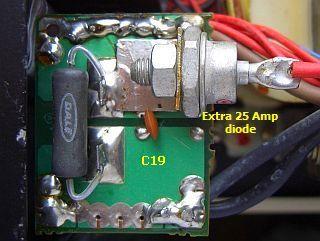
During the mentioned test a 2N3055-power transistor had gone short circuit also by lose fixing and nil paste. Again, check your power supply for essential fixings and sufficient thermal paste.
VOLTAGE REMAINS
When the power is switched off, the voltage remains for some time. For a faster discharge a load resistor (fig») was installed parallel to the unregulated voltage across capacitor (C19).
EXTRA DIODE
If the supply is used for battery charging it may happen that the power is switched off before the battery is removed or the battery is connected before the unit is on. Temporarily components can have a reverse polarity and failure. A large diode (fig») mounted from the positive terminal to the plus pole of C19 can avoid this.
|
|
|
DIODE EN EXTRA FUSE
If accidentally the poles of a battery are reversed, diode D8 (1N4001) conducts and not survives. One can installed the known reverse protection circuit by replacing a stronger diode type (> 20A) and an additional output (25A) fuse. In case of wrong connection the diode conducts and the fuse blow.
OTHER FAN
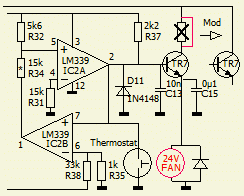
The original 12 V fan was too noisy and did not sufficiently cooled at maximum load. That is mainly because the insufficient mounting of all components. One resistor («fig) was removed or short circuit and a powerful fan type was replaced: a 24 V PAPST Multifan 8314. Now the airflow is sufficient with less noise.
The resistor in TR7's collector is not always installed in this type of power supply!
G3MWO cured the overheating by running the fan slowly all the time - but also added a series of 6 mm holes in the bottom of the case just in front of the heatsinks for air flow through the lower heatsinks.
PAØKV's MODIFICATIONS
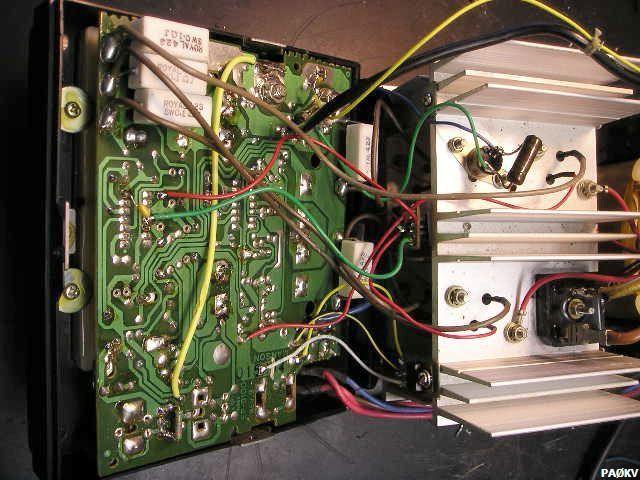
PAØKV has designed some interesting changes. He was not satisfied with the voltage stabilization at maximum load. In examining the cause he discovered a number of weaknesses of the design. In his enthusiasm to proceed, he thought the changes might be too far. However the result was a safe, quiet and stable 13.8 V supply for its transceiver. His findings are given below.
STABILITY
The LM723 (IC1) voltage regulator is not working properly despite feeding with a separate winding on the transformer. The output voltage varies considerably due to the heavy load of the system to the other secondary winding and probably by thin wire on the primary windings.
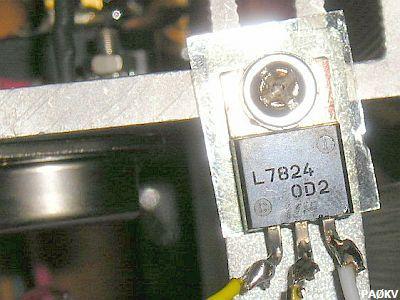 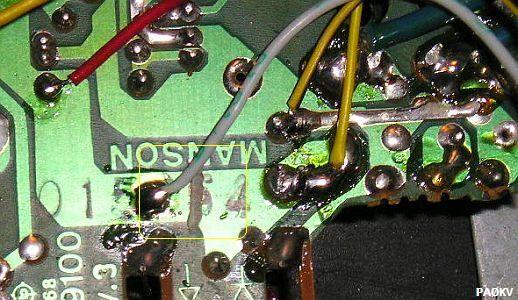 |
 The changes are marked in red. The circuit for the fan is simplified. |
To improve, he replaced D13 (1N4001) with an additional 24 V stabilizer (7824) mounted on the heat sink and a track was interrupted. Since C17 was not installed in his EP-925 he mounted a 100 nF capacitor.
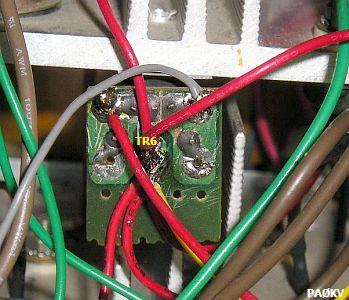
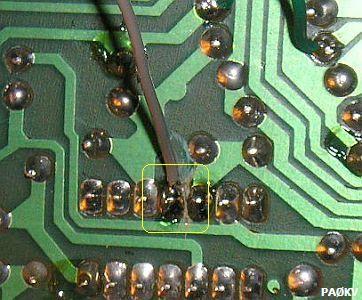
The circuit of the LM723 (IC1) voltage regulator could be improved. NPN TR6 (TIP31C) was replaced by a PNP transistor TIP42C with increased HFE that contribute to the stabilization. A track (fig») below IC1 was cutted. Further pin 12 (V+) was connected to 7824, pin 11 (Vc) to the base of TIP42C, pin 10 (Vout) to the emitter of TIP42C. Resistor R7 (1.8 k) replaced by 680 ohms and R8 (22 Ohm) and D5 (1N4001) removed.
The inputs of the LM723 were designed for lower voltages (up to 9 V) to the outputs. He chose for 13.8 V, R14 was reduced to 680 ohms. He decreased the maximum voltage across VR3 (5 kOhm) to 14 V with a 1.2 kOhm resistor in parallel of VR3.
SAFE OVERVOLTAGE

For maximum 14 V voltage at the output terminal he applied a 16 V overvoltage protection. A thyristor (BTV24/1400R) was mounted in parallel with (fig») an installed bridge rectifier (50 A/120 V). A zener diode (ZD2) and resistor (100 ohms) across the output trigger the action.
FAN
In his opinion the circuit for the fan is overly complicated: a thermostat, two opamps and a transistor to switch a fan! I am agreeing! The reason is probably the use of an NC (Normal Closed) thermostat.
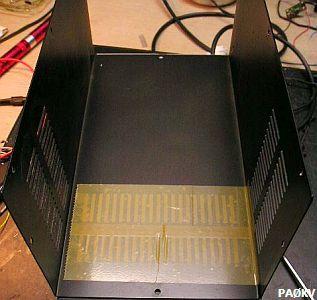
The fan was replaced by a PAPST 844414NG and mounted to suck the hot air out of the casing. Thus reduces noise considerably. To increase the airflow through the side slits, he sealed the air gaps («fig) of the lid with tape.
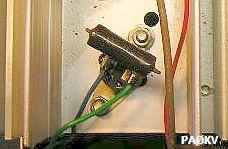
The original fan's supply system was superfluously because the thermostat was replaced by an N-type (Normal Open) in series with the fan. With a («fig) 220 Ohm/5 W resistor parallel to the thermostat the fan runs quietly at half speed and constantly cooled the heat sinks. It's never happened that the fan was running at full capacity.
LY3BG MODIFICATIONS
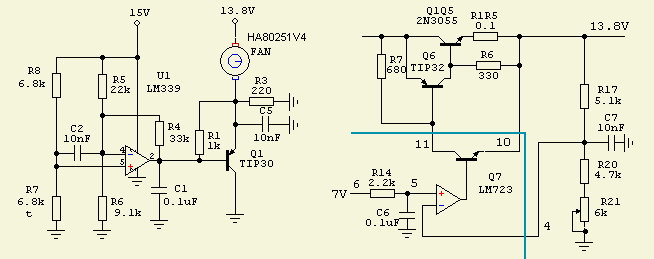
Left: R7 (6k8) is a thermistor, FAN = silent fan; Right: R1-R5 = 0.1 Ohm.
![]()